September 30th 2004
I've been travelling again. This time, not even I, with my nigh-indefeasible propensity to look on the bright side, can claim that I was lucky with the weather. Actually, I came home a day early, just ahead of a typhoon. This, Typhoon 21, was the eighth to actually strike Japan this year, which I gather is a very high number, so I've done quite well to avoid them on previous trips.
Still, the trip was good until the weather hit the 'small natural disaster' point.
The trip started on Sunday, when I went to Osaka. This was my first visit to the city, although I'd seen the Shinkansen station on the way through a few times. Another of my friends from England, Takako, met me at the station, and we spent the afternoon seeing a couple of the sights of Osaka.
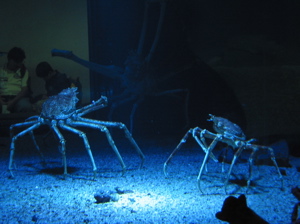 The Giant Spider Crabs at Osaka Aquarium.
The Giant Spider Crabs at Osaka Aquarium.
Our first visit was the aquarium, which is one of the largest in the world. Unlike many aquaria, this one doesn't have dolphin or seal shows, although it does have dolphins. Instead, it has a series of tanks representing the various environments found around the edge of the Pacific Ocean, from tropical islands to Antarctica. In the centre is an enormous tank representing the Pacific Ocean itself. There are sea otters, dolphins, seals, penguins, and many, many fish. The picture on my admission ticket is of monkeys, but nevermind.
The exhibits are very impressive; the central tank has a whale shark and manta ray (which looks very strange -- it really looks as though it flies under water), and there are more varieties of fish than I could count. The tank containing giant spider crabs from the Japan Deeps was particularly eerie; they really looked like aliens. Part of the reason for that is that their legs probably could not support their body weight, at least not in those positions, in the air. Thus, they look somehow wrong.
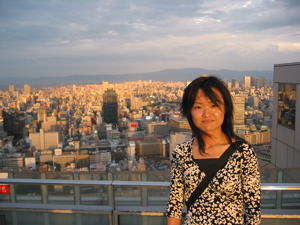 Takako on the observation platform, with Osaka in the background.
Takako on the observation platform, with Osaka in the background.
For lunch, we had Okonomiyaki, which is an Osaka speciality, and it was very good. We then went to the Midair Floating Garden Observation Platform. There are no plants in this garden, but the rest of the description is quite accurate. The observation area is over the space between two towers, and the last stage of the journey up is on an escalator that goes over the gap. I tried not to think about earthquakes too much at that point.
The view was spectacular, and as we were there in the evening we watched the sunset from the top, and then waited for darkness so that we could see the night view. Osaka really is quite impressive from that angle.
After that, Takako had to go home as she was working on Monday, and I ate, went back to the hotel, and slept. On Monday morning I had originally planned to do some more sightseeing, but it was absolutely pouring with rain, and anyway I didn't have quite as much time as I would have liked, so I just took things easy and got to my train really early. This was the train to Miyajima.
Actually, of course, since Miyajima is an island, there were two trains and a ferry involved, but the connections were almost perfect, so I had a good journey. Thanks to prior warning from Mum, I was able to get onto the correct side of the pier to take pictures of the torii and shrine as we came into dock, but unfortunately the tide was out at that point.
Miyajima is a UNESCO World Heritage Site, but still susceptible to typhoons. A couple of weeks or so ago, one of this year's powerful typhoons struck the island, doing a lot of damage, including damage to Itsukushima Shrine, the main attraction. As a result, the shrine itself was closed while repairs went on. This was unfortunate, but not too bad, as you can't actually go very far into the shrine even whe it is open.
The first thing I saw when I got off the ferry was a deer, in the ferry terminal, trying t get food off tourists. There were a lot of deer around, and while they generally seemed wilder than the ones in Nara, they certainly weren't scared of people, and wandered pretty much wherever they wanted. I called the ryokan from the ferry terminal (the connections had been a bit too good, perhaps; I hadn't been able to call earlier), and they came t pick me up. The drive back took us up narrow streets, and then along tracks, in one case through the middle of a tree trunk felled by the storm on only partially cleared.
Momiji-sou, the ryokan where I stayed, is in the middle of Momiji-dani Park, and the scenery must be absolutely gorgeous when the maple leaves are turning. I imagine they're quite busy then, too. The room was very nice, the food was delicious, and the service was great. In all, a nice place to stay.
On Monday afternoon, I took the ropeway (cable car) to the top of Misen, the holy mountain on the island. The cable car takes you to one peak, and the view from there must be really spectacular on clear days. Even with clouds and occasional drizzle, it was good. The view is over the Seto Inland Sea, the whole of which, pretty much, is a national park. There are lots of small, mountainous, forested islands, with industrial cities on the shores of the mainland beyond.
From that peak, you can walk fairly easily to the other, higher peak. The mountain is covered in primeval forest, but the paths through are thoroughly artificial, making use of concrete steps and the like. Still, considerable effort has been taken to make them fit the environment, by using natural stone and such, so it isn't too bad.
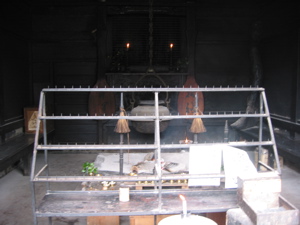 The eternal flame on Misen. The fire is behind the rack for candles. It's not built up very high.
The eternal flame on Misen. The fire is behind the rack for candles. It's not built up very high.
On the way up to the peak, the path passes through a plateau containing three temple buildings. One is the main hall of the mountain temple, another a side temple. The third contains an eternal flame, which, according to legend, has been burning since Kobo Daishi lit it, over 1200 years ago. Kobo Daishi is one of the most important figures in the history of Japanese Buddhism, and the main temple on the mountain (see later) was founded by him.
Attached to the eternal flame hall was a small stall selling o-mamori. There was, however, no staff. Instead, you put your money into a little box after selecting the charm you wanted. I bought myself another study charm, as a nice souvenir from most of the way up a mountain.
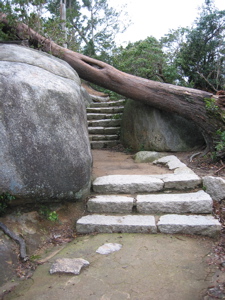 A fallen tree forming a natural low gate with the help of some boulders.
A fallen tree forming a natural low gate with the help of some boulders.
The path to the summit still showed numerous signs of storm damage. The fallen trees had been cleared sufficiently to allow passage, but at some points I still had to step over small trunks, duck under larger ones, or go round through the narrow space at one end of a fallen tree.
The main peak of the mountain is covered with large boulders, formed into interesting shapes. A lot of them have small Buddha status on them, and seem to have been regarded as sacred for a very long time. The peak of the mountain also has a viewing platform and little cafe, which really isn't very impressive, but is quite welcome on the top of the mountain.
After looking around, I came down a slightly different route, past another shrine, and then decided to walk all the way down the mountain, rather than getting the cable car back.
This was a wonderful walk. I didn't see a single human being the whole way, which was about a mile. The path runs along a stream, which is more a river by the bottom, and the primeval forest stretches up to your left and down to your right, with large boulders cropping out to either side.
I only discovered at the bottom that the stream is largely artificial. There was a natural stream, but after it buried Itsukushima Shrine in mud after one typhoon the government decided to put in erosion control works. Most of these are very well designed, to look almost natural. Indeed, in some cases they don't look natural because they're a bit too beautifully placed. As a flood control scheme, it certainly looks nicer than a bunch of sandbags.
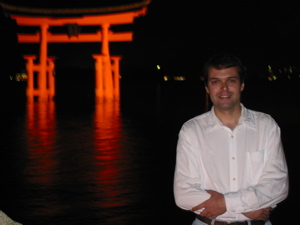 Me in front of the Torii at Miyajima.
Me in front of the Torii at Miyajima.
There weren't very many guests at the ryokan, and at dinner I got talking to the other guest, another Englishman, called Simon. As a result, we went down to the shrine after dinner together. We needed a torch, because the lighting in the park was still down after the storm, but the path was fairly easy to find, and took us straight through the middle of Iwaso Ryokan, where Mum and Ray stayed.
It was well worth the walk. The tide was in, the torii was lit up, and the view was beautiful. One advantage of having two of us there was that we were both able to get photographs including both us and the torii.
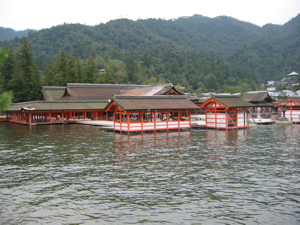 Itsukushima Shrine, at high tide.
Itsukushima Shrine, at high tide.
On Tuesday, I decided to spend the morning seeing the various structures in the town around the bay, and then do the mountain again in the afternoon. The tide was in in the morning, so the shrine really did look as though it was floating on the water. It's not just the torii that's built out in the bay; the whole shrine is, although the main shrine is built right at the edge. Still, the tide comes in under the shrine.
There are a number of other religious buildings in the area, including, up on a hill, a large hall and five-storey pagoda. The hall was built by Toyotomi Hideyoshi, and left unfinished after his death, when the Tokugawa took control of Japan. It was very nearly finished, though, and it is a very spectacular structure.
My original plan was to take a different path part way up the mountain, and see another temple, but when I got the start of that path I was faced with about twenty feet of fallen trees. There were no signs saying 'path closed', but sometimes, you know, that really is redundant. So I abandoned that plan and went back into town for lunch. Lunch ended up being oysters on rice, which was on special offer to celebrate the 60th anniversary of the shop selling them.
From there, I decided to do the mountain again, going up the path I'd come down the day before, and then down a different path, taking me to the main Buddhist temple on the island.
Going up a mountain is harder work than coming down one. Possibly, particularly if you came down it the previous day and have spent the whole morning walking around. For most of the way, I took my tee-shirt off in an attempt to stay slightly cooler, and I think it worked a bit. The environment was still spectacular, and I did get all the way to the top again.
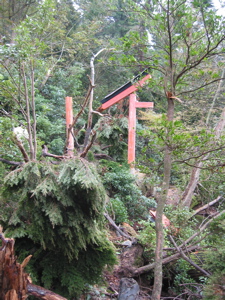 The ruins of the torii at the end of the main path to Miyama Jinja.
The ruins of the torii at the end of the main path to Miyama Jinja.
On the way down, I took a slight detour to Miyama Shrine. This shrine is built on a spur of the mountain, and has the most amazing site of any shrine I've seen yet. The spur falls off steeply on three sides, so the shrine stands above a landscape of forested mountains, with an island-studded sea in the background. I tried to take photographs, but they really couldn't do it justice. There was a second path leading down from the shrine, but I wasn't sure where that would link up, so I decided not to take it, and retraced my steps to continue the the descent to Daishouin Temple.
I soon discovered that I had made the right decision, because I passed the other end of the second path. Normally, it is the main entrance, because there is a torii at its terminus. Normally. At the moment, there is a shattered torii and a large tree. It looks like the typhoon dropped a tree right on the centre of the torii, thoroughly blocking that path. Again, no-one had seen the need to put a sign up... There is another temple on the mountain, the 'Okunoin' or 'Inner Temple', which I suspect is currently inaccessible. Certainly, all the paths I saw that normally lead there were quite thoroughly blocked.
From Miyama Shrine, I continued my descent of the mountain. This path is clearly artificial, because it is mainly a series of steps. About a mile of steps. Again, it runs along a river, in a narrow valley with primeval forest up both sides. Occasionally there is a spectacular view, when the path crosses a ridge, but most of the time you are almost completely enclosed by the trees. At intervals along the path small shrines stand, mostly remarkably undamaged-looking; perhaps this was a slightly sheltered valley when the typhoon hit.
It might have been sheltered then, but it certainly didn't seem sheltered when it started raining as I was part of the way down. Instead of letting up, as previous rain had, it got heavier. And heavier.
After a few minutes, I reached a shelter built on a small plateau, and I went in there to wait. The rain developed into a thunderstorm, and over the course of about half an hour three Japanese people joined me. One of them very kindly lent me his spare waterproof coat, and walked all the way back to the ryokan with me so that I could return it to him after I reached somewhere dry.
The path took us past Daishouin, which looked superb, but it was still raining heavily, so I didn't stop to look.
I got back to the ryokan, and the first thing I did was take a shower. The ryokan served dinnner in my room, which they don't usually do, and I went to bed very early, with an exhaustion and chill headache.
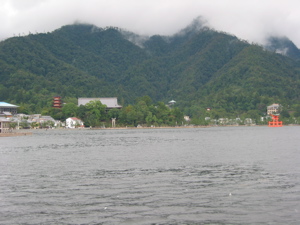 Miyajima from the departing ferry.
Miyajima from the departing ferry.
And then, at about 8:30, I woke up, and I next got to sleep about 1:30. I have no real idea why. It was still raining, and my right knee was a bit sore from climbing the mountain, but I don't know why I found it quite so hard to sleep at all.
My original plan was to go to Mount Koya yesterday, and spend the night in a Buddhist temple. The arrival of a typhoon made that seem like a less sensible idea, so I phoned to cancel in the morning, and instead got the first shinkanse home that I could. I didn't quite beat the rain back; I got soaked again getting back from the station to my flat.
I think I'd like to go back to Miyajima, some time when the weather is better. It's a truly beautiful island, and I'd like to see Daishouin properly, as well as do the mountain walk again.
Still, one thing I noticed on this trip; I wasn't immediately filled with enthusiasm for the next one. I think I may have largely sated my desire to see as much of Japan as possible.
One Year
Today is the last day of my first year in Japan, which makes it a good time for a general retrospective. I've already looked back over school, so this will be more general. I've enjoyed the year, and it's been packed. My Japanese has improved immensely, and I've got a lot out of the school. I've been to all four main islands, most of the major cities, and many of the main tourist spots. I've seen most of the Japanese friends I made in England, and made new friends here.
It's been good. Here's to the future years.